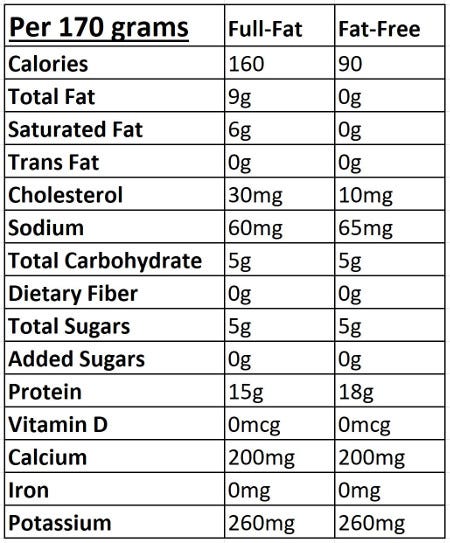Records of Greek yogurt date all the way back to the 5th century BC. Greek yogurt is strained to remove whey, which makes it thicker and creamier than standard yogurt. It can be enjoyed on it’s own, with fruit added, as a base for sauces (eg. tzatziki sauce), or as an ingredient in a sweet or savory dish.

It tastes best in its normal, full-fat form (at least for most people), but can also be found in low-fat and fat-free varieties. The latter two varieties throw up red flags for people, and understandably so. But why the red flags? Well, understandably, there are a lot of foods that are marketed as having reduced fat or no fat, but in lieu of the fat is often sugar or chemical fillers.
But when it comes to plain Greek yogurt, it can easily be found in low-fat and fat-free varieties where there are no additives, with the only alteration being the removal of fat.
One may worry how the fat is removed, but fear not. Prior to the yogurt making process, the whole milk has its fat removed by centrifugal force by a centrifugal separator. In simpler terms, the milk is spun really fast and the fat is separated.

Once the fat has been removed from the milk, the yogurt processing begins, just as it would with full-fat Greek yogurt. The end result is a yogurt that is almost identical to full-fat Greek yogurt, but with less calories and fat. Here is a side-by-side comparison of the nutrition facts of the full-fat and fat-free Greek yogurts by the most popular brand in the United States.

Now that it’s been made clear that there are no unhealthy additives, let’s move on to the next concern. As many are discovering, fat is not the culprit that it has been made out to be. Because of this, and the many realizations of the benefits and necessity of dietary fat, people will avoid fat-free Greek yogurt because they have a negative perception of it due to the removal of healthy fat. There is an idea that this “less healthy” fat-free version should be avoided. So, are there benefits?
Why, of course. Consuming fat-free Greek yogurt doesn’t mean that fat is necessarily being avoided. In many cases, the consumer views it more as a protein addition. Fat-free Greek yogurt can be a very useful tool in hitting macronutrient and calorie goals, or allow one to allocate fat elsewhere while adhering to their goals.
Here’s an example. Someone is trying to keep their daily calorie consumption at 2,200, with 180 grams of protein, 160 grams of fat, and 10 grams of carbohydrates. 160 grams of fat is equal to 1,440 calories, meaning that the diet is 65.4% fat. They are going to eat a ribeye for dinner, so to make sure they can adhere to their goals, they eat fat-free Greek yogurt earlier in the day to allocate more fat to their dinner. If they had eaten full-fat Greek yogurt, they would not be in compliance. This person is consuming a high-fat diet, but using fat-free Greek yogurt as a tool as a tool to help them to hit their goals.
Greek yogurt is a great tasting and very versatile food, and its availability in different varieties of fat content have made it a favorite of many health-minded individuals.